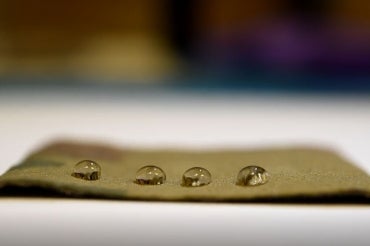U of T researchers develop safer alternative to non-stick coatings

This piece of fabric is coated with a new non-stick material made via a technique called nanoscale fletching, developed by researchers in the department of mechanical and industrial engineering in U of T's Faculty of Applied Science & Engineering (photo by Samuel Au)
Published: July 29, 2025
A new material developed by University of Toronto researchers could offer a safer alternative to the non-stick chemicals commonly used in cookware and other applications.
The substance is capable of repelling water and grease about as well as standard non-stick coatings; it also contains far lower amounts of per- and polyfluoroalkyl substances (PFAS), a family of chemicals – that includes Teflon – that have raised environmental and health concerns.
It was developed in the Durable Repellent Engineered Advanced Materials (DREAM) laboratory at U of T’s Faculty of Applied Science & Engineering using a novel chemistry technique described in Nature Communications.
“The research community has been trying to develop safer alternatives to PFAS for a long time,” says Kevin Golovin, an associate professor in the department of mechanical and industrial engineering who heads the DREAM lab. “The challenge is that while it’s easy to create a substance that will repel water, it’s hard to make one that will also repel oil and grease to the same degree. Scientists had hit an upper limit to the performance of these alternative materials.”
Since its invention in the late 1930s, Teflon – also known as polytetrafluoroethylene or PTFE – has been prized for its ability to repel water, oil and grease alike.
Its non-stick properties are the result of the inertness of carbon-fluorine bonds, with PFAS molecules consisting of chains of carbon atoms, each bonded to several fluorine atoms.
However, this chemical inertness also causes PFAS to resist the normal processes that would break down other organic molecules over time. For this reason, they are sometimes called ‘forever chemicals.’
In addition to their persistence, PFAS are known to accumulate in biological tissues, and their concentrations can become amplified as they travel up the food chain.
Various studies have linked exposure to high levels of PFAS to certain types of cancer, birth defects and other health problems, with longer-chain PFAS generally considered more harmful than the shorter-chain variety.
Despite the risks, the lack of alternatives means that PFAS remain ubiquitous in consumer products: in addition to cookware, they are used in rain-resistant fabrics, food packaging and cosmetics.
The material Golovin’s team have been working with is an alternative to PFAS called polydimethylsiloxane (PDMS).
“PDMS is often sold under the name silicone, and depending on how it’s formulated, it can be very biocompatible – in fact it’s often used in devices that are meant to be implanted into the body,” says Golovin. “But until now, we couldn’t get PDMS to perform quite as well as PFAS.”
To overcome this problem, PhD student Samuel Au developed a new technique called nanoscale fletching which involves bonding short chains of PDMS to a base material – which Au likens to bristles on a brush.
“To improve their ability to repel oil, we have now added in the shortest possible PFAS molecule, consisting of a single carbon with three fluorines on it. We were able to bond about seven of those to the end of each PDMS bristle,” says Au.
“If you were able to shrink down to the nanometre scale, it would look a bit like the feathers that you see around the back end of an arrow, where it notches to the bow. That’s called fletching, so this is nanoscale fletching.”
The team coated the new material on a piece of fabric, before placing drops of various oils on it to test its repellency.
The coating achieved a grade of 6 on an American Association of Textile Chemists and Colorists scale – placing it on par with many standard PFAS-based coatings.
“While we did use a PFAS molecule in this process, it is the shortest possible one and therefore does not bioaccumulate,” says Golovin.
“What we’ve seen in the literature, and even in the regulations, is that it’s the longest-chain PFAS that are getting banned first, with the shorter ones considered much less harmful. Our hybrid material provides the same performance as what had been achieved with long-chain PFAS, but with greatly reduced risk.”
Golovin says the team is open to collaborating with manufacturers of non-stick coatings who might wish to scale up and commercialize the process. In the meantime, they will continue working on even more alternatives.
“The holy grail of this field would be a substance that outperforms Teflon, but with no PFAS at all,” says Golovin. “We’re not quite there yet, but this is an important step in the right direction.”



